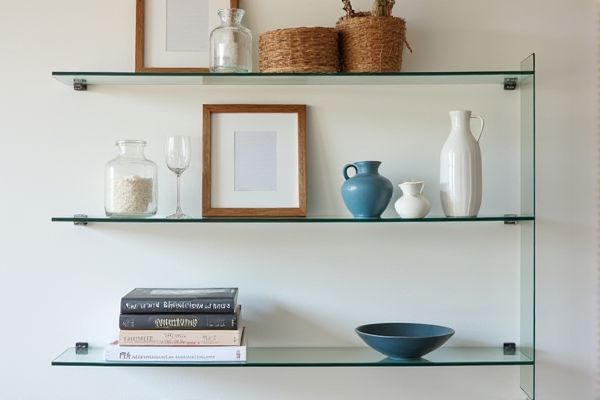
Acrylic shelf dividers provide a sleek, modern look and are easy to clean, making them ideal for organizing items in kitchens and closets, while wire shelf dividers offer greater airflow and durability, suitable for pantry or garage storage where breathability and strength matter. Discover which option best suits Your storage needs by reading the full comparison in the rest of this article.
Table of Comparison
| Feature | Acrylic Shelf Dividers | Wire Shelf Dividers |
|---|---|---|
| Material | Clear acrylic plastic | Metal wire, usually coated |
| Durability | Strong, scratch-resistant | Durable, prone to bending |
| Appearance | Modern, transparent, sleek | Industrial, open design |
| Weight | Lightweight | Heavier than acrylic |
| Installation | Easy to install, snaps or slides into shelves | Easy to clip or hook in place |
| Cleaning | Wipes clean easily | Dust collects, requires more cleaning |
| Cost | Moderate price | Generally lower price |
| Use Cases | Retail displays, home organization, attractive setups | Storage rooms, garages, heavy-duty organization |
| Flexibility | Less flexible, rigid structure | Flexible, adapts to various shelf sizes |
Introduction to Shelf Dividers: Acrylic vs Wire
Acrylic shelf dividers offer a sleek, transparent design that enhances visibility and adds a modern aesthetic to storage spaces. Wire shelf dividers provide sturdy, breathable separation with a lightweight metal construction ideal for ventilated shelving. Choosing between acrylic and wire dividers depends on the desired durability, visual appeal, and specific storage needs.
Material Composition and Durability
Acrylic shelf dividers are made from solid plastic that offers a smooth, clear finish and high resistance to moisture and impact, making them durable for long-term use. Wire shelf dividers consist of metal, typically steel with a powder-coated finish, providing strong structural support but potentially prone to rust or bending under heavy loads. Your choice depends on whether you prioritize the sleek, modern look and resilience of acrylic or the sturdy, industrial strength of wire dividers.
Aesthetic Appeal and Design Options
Acrylic shelf dividers offer a sleek, modern aesthetic with a transparent, polished finish that seamlessly integrates into contemporary interiors, enhancing visual openness and clarity. Wire shelf dividers provide a more industrial or utilitarian look, featuring metal construction with various coatings like chrome or powder-coated finishes, suited for rugged or minimalist design themes. Acrylic options allow for a wider range of shapes and customizations, including tinted and frosted designs, while wire dividers prioritize functional durability with limited stylistic diversity.
Installation Process and Compatibility
Acrylic shelf dividers offer a straightforward installation process with clip-on or adhesive options, making them compatible with most flat, smooth surfaces like wood or laminate shelves. Wire shelf dividers require mounting brackets or clips, which can be more complex to install but provide strong support for metal or wire shelving systems. Compatibility varies, as acrylic dividers suit modern and minimalist shelves, while wire dividers are ideal for industrial or wire rack setups.
Strength and Weight Capacity
Acrylic shelf dividers offer superior strength and can support heavier items without bending or warping, making them ideal for sturdy storage needs. Wire shelf dividers, while lightweight and ventilated, generally have a lower weight capacity and may deform under heavy loads. Choosing acrylic dividers ensures enhanced durability and reliable support for heavier or denser objects.
Maintenance and Cleaning Requirements
Acrylic shelf dividers require minimal maintenance, as their smooth surfaces resist stains and can be easily wiped clean with a damp cloth and mild detergent. Wire shelf dividers tend to accumulate dust and debris in crevices, necessitating more frequent cleaning with brushes or compressed air to maintain hygiene. Both materials benefit from regular cleaning, but acrylic dividers generally offer a quicker and more straightforward cleaning process compared to wire dividers.
Cost Comparison: Acrylic vs Wire
Acrylic shelf dividers typically cost more upfront than wire shelf dividers due to their durable, clear construction and sleek appearance. Wire shelf dividers offer a more budget-friendly option, with prices generally lower because of their simpler materials and manufacturing process. When factoring in long-term durability and aesthetic appeal, acrylic dividers may provide better value despite the higher initial investment.
Versatility in Storage Solutions
Acrylic shelf dividers offer clear visibility and a sleek design, making them ideal for organizing items without obstructing your view, enhancing versatility in storage for kitchens, offices, and closets. Wire shelf dividers provide sturdy support and better airflow, perfect for items that require ventilation such as pantry goods or shoes, adding functional flexibility. Choosing between acrylic and wire shelf dividers depends on the type of items you store and the level of visibility or ventilation your space requires for optimal organization.
Common Use Cases in Different Spaces
Acrylic shelf dividers are commonly used in kitchens and bathrooms for organizing cookware, toiletries, and pantry items due to their sleek appearance and easy-to-clean surfaces. Wire shelf dividers are preferred in garages, warehouses, and retail stores where durability and ventilation are important for storing tools, equipment, and merchandise. Your choice depends on the environment and the specific items you need to organize, with acrylic offering aesthetic appeal and wire providing strength and airflow.
Final Verdict: Choosing the Right Shelf Divider
Acrylic shelf dividers offer a sleek, modern look with clear visibility and sturdy support ideal for maintaining a clean, organized space. Wire shelf dividers provide better airflow and are more flexible for heavier or irregularly shaped items, making them suitable for versatile storage needs. Selecting the right shelf divider depends on balancing aesthetic preference with functional requirements like durability, visibility, and ventilation.
 homyna.com
homyna.com